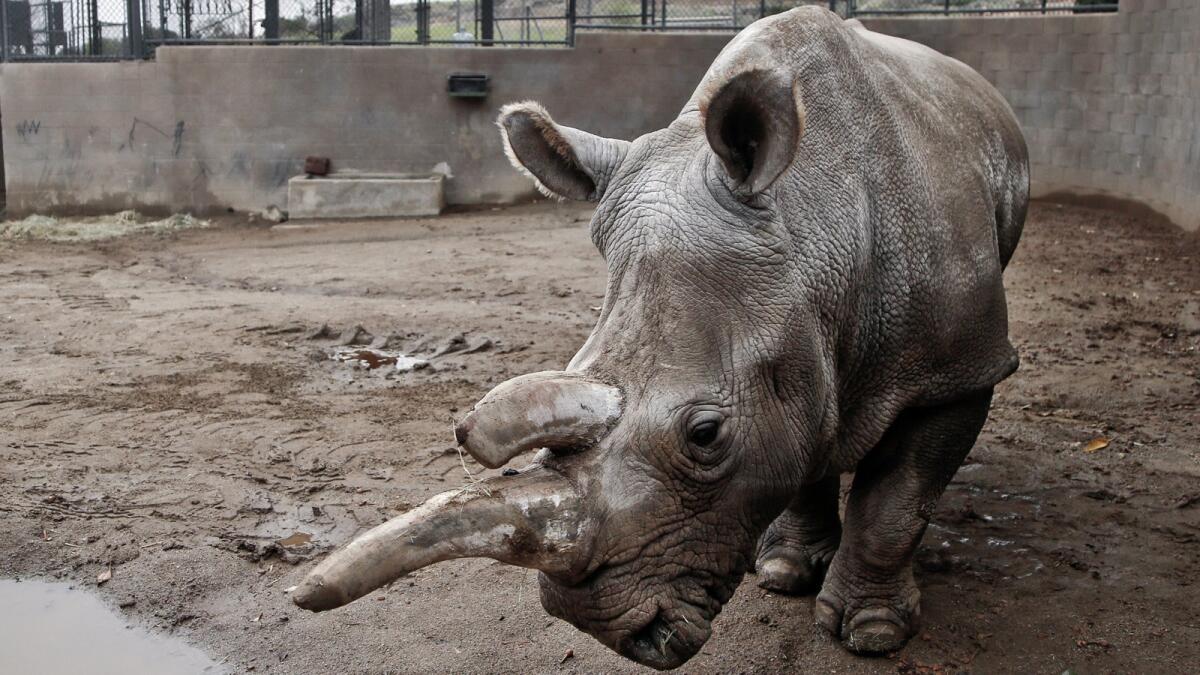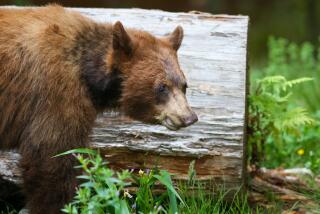Horns and body of Nola, rhino who died at Safari Park, to be preserved at Smithsonian

The horns and body of Nola, the northern white rhino who died Sunday at the San Diego Zoo Safari Park, will be taken to the Smithsonian for research. Tissue samples were already taken after her death to be used in research toward finding a way to keep the species from going extinct.
Reporting from San Diego — The horns and body of Nola, the northern white rhino who died Sunday at the San Diego Zoo Safari Park, are being sent to the Museum of Natural History at the Smithsonian Institution in Washington to assist researchers.
Nola’s death leaves only three northern white rhinos in the world - all in the Ol Pejeta Conservancy in Kenya. At 41, Nola was in rapidly declining health; zookeepers on Sunday opted to euthanize her.
Nola’s horns and body will be kept in the off-exhibit area at the Smithsonian with materials from other northern white rhinos in order to help researchers “continue to study this magnificent species,” the San Diego Zoo announced Tuesday.
NEWSLETTER: Get essential California headlines delivered daily >>
In the minutes after Nola’s death, researchers at the zoo’s Institute for Conservation Research collected ovarian and uterine tissue samples for storage in the institute’s Frozen Zoo for study. The Frozen Zoo has genetic material from 11 other northern white rhinos.
But as expected, researchers found that her eggs were not viable and thus were not collected.
The Frozen Zoo has semen from male northern white rhinos but no eggs. No method exists for removing the eggs from a living northern white rhino.
Despite long odds, the zoo’s research institute, along with the Scripps Research Institute in La Jolla, the Institute for Zoo and Wildlife Medicine in Berlin, and the Ol Pejeta Conservancy in Kenya - are determined to preserve the northern white rhino species.
Nola arrived at the Safari Park in 1989 from a zoo in what is now the Czech Republic and quickly became a favorite of zookeepers and visitors.
She did not succeed in giving birth - although at one time, the Safari Park had two male northern white rhinos. One has since died, the other was transferred to another facility.
As the panda is the poster animal for the San Diego Zoo, the rhino plays the same role for the Safari Park, beginning with a large cutout at the park entrance.
“Although Nola did not reproduce in her long lifetime, she touched the hearts of everyone who was fortune enough to meet her,” said Barbara Durrant, director of reproductive physiology at the conservation institute.
Various options are being considered to preserve the species or possibly reintroduce it after the three remaining rhinos die.
One option is a hybrid between the northern white rhino and the southern white rhino. Another option is to create a northern white rhino embryo - possibly from a stem cell line - and use a southern white rhino female as a surrogate.
Six southern white rhino females arrived at the Safari Park this month from South Africa to act as possible surrogates.
Nola’s passing “only strengthens our commitment to develop the technology needed to realize the goal of producing an offspring from Nola’s preserved cells,” Durrant said.
The task will be neither easy nor quick. Durrant has predicted a northern white rhino offspring by 2023.
Making the venture more difficult is fact that the three remaining northern white rhinos in Kenya all have reproductive issues: Sudan, 43, the male; and the females Najin, 26, and Fatu, 15. The sanctuary has 24-hour armed guards to protect the rhinos from poachers.
Rhinos are in dire condition around the globe because of poaching, habitat destruction and warfare. Some conservationists have predicted that rhinos could disappear within a generation.
Durrant and others, however, hope that knowledge gained in the pursuit of a northern white rhino offspring could assist in projects to help other species of rhinos.
Twitter: @LATsandiego
ALSO
‘Full House’ actor John Stamos convicted of DUI in Beverly Hills
Costco chicken salad linked to E. coli outbreak in California, other states
Jury orders Kabbalah Centre and former director to pay $177,500 in sexual assault lawsuit
More to Read
Sign up for Essential California
The most important California stories and recommendations in your inbox every morning.
You may occasionally receive promotional content from the Los Angeles Times.









